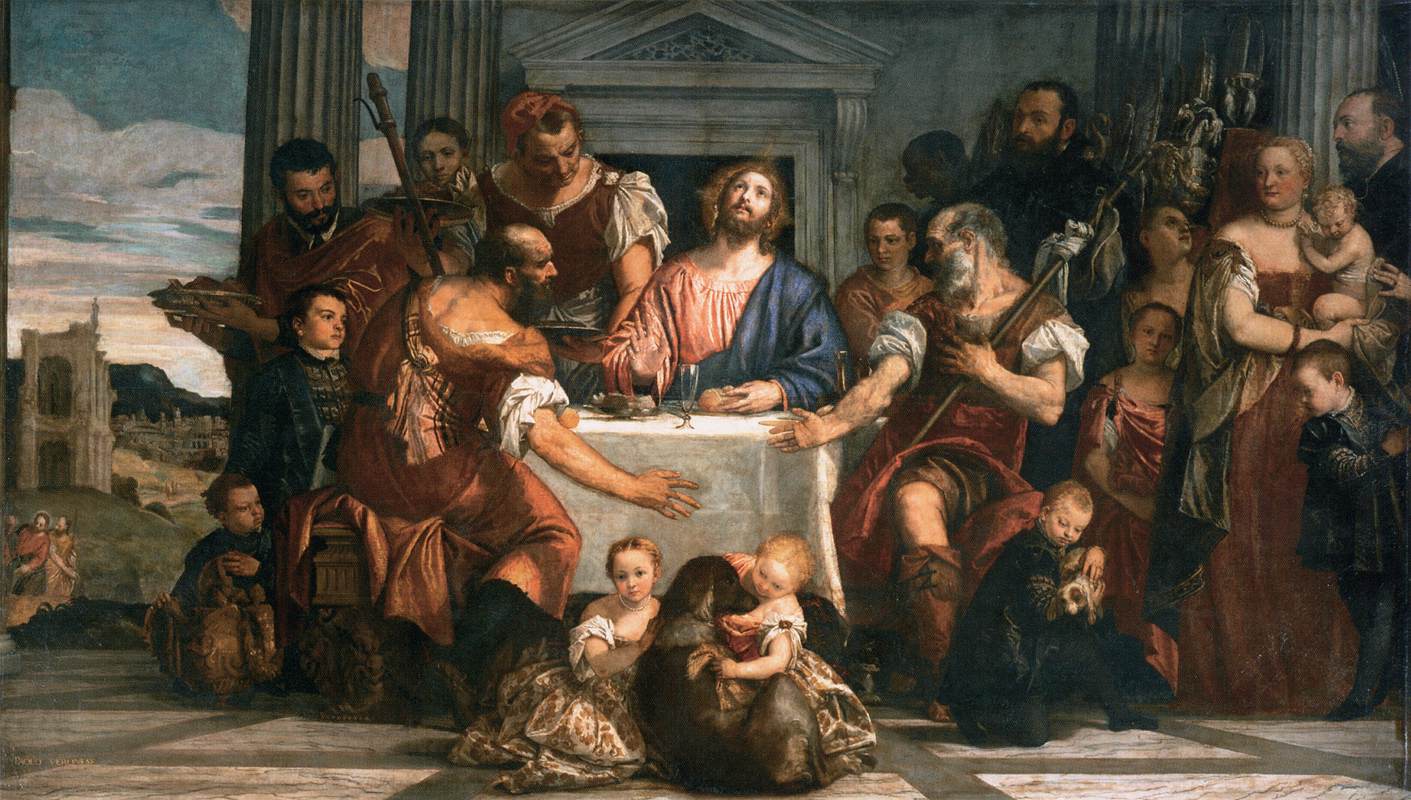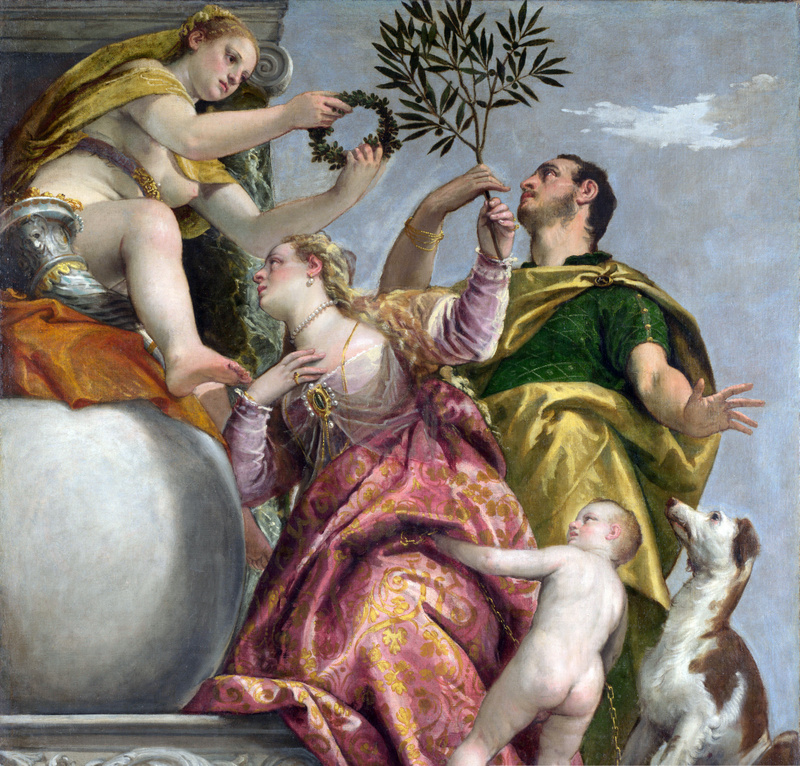Veronese: Magnificence in Renaissance Venice
David Packwood
Veronese: Magnificence in Renaissance Venice is on at the National Gallery, London, 2014 until the 15th June 2014.
It was written, then, on my page in the Book of Fate that at two in the afternoon of the sixth day of June in the year 2014 that I, along with a friend, should attend an exhibition of Paolo Veronese for the first time within the hallowed halls of the London, National Gallery. “Veronese” is no longer just a name to me, or a reproduction in a book, or a digital image floating on a computer screen. In this exhibition I begin to grasp the man behind the banquets, the purveyor of large altarpieces, the manufacturer of political allegories- the man who unwittingly gave birth to a school in which the best pupil was the sublime Tiepolo.

Paolo Veronese (1528-1588), 'The Anointment of David' about 1550 Oil on canvas. 173 x 365 cm © Kunsthistorisches Museum Wien Gemäldegalerie
If I am to describe this exhibition of Veronese’s paintings for an audience, I will need to provide a short sketch of the layout and design of this event, though I could never recapture that first fresh innocence of seeing the pictures for the first time, before dust gathered on the paintings, before restoration took its toll. Neither can I reconstruct the original context which is far from the drab rooms of battleship grey that the curators have chosen for a backdrop for Veronese’s paintings. Why have Xavier Salomon and Nicholas Penny made this decision? Veronese is a colourist and that is why he was admired by the likes of Turner, Delacroix and others. I am told that battle- ship grey is spreading across the walls of the museums of Europe, and it reminds me that Delacroix says somewhere that grey is the enemy of painting, and he is right! Battleship grey is not suitable décor for a painter who likes all kinds of blues, ultramarine, smalt; a range of greens, moss green, verdigris; frosty pinks and creamy whites and vivid crimsons- he is one of the greatest colourists that Venice produced, and to put his pictures of glorious colours in rooms darkened by drab grey is to diminish their effect. There now, I’ve said my piece. Let me guide you round this exhibition.
Brief Description of Layout.
Seven rooms containing fifty works: modellos, large and small altarpieces, huge portraits in vertical formats, smaller ones on the intimate scale, crowd scenes, adorations, conversions, miracles, a gigantic martyrdom, a roomful of allegories, late mythologies, though inexplicably not one drawing, only an oil sketch for an early altarpiece. All this situated not in the usual underground exhibition space of the NG, but in some of their main galleries which makes the exhibition seem sprawling at times.
Room 1: Early Works: 1545-1560.
Here we see Veronese’s first faltering steps; learning to walk before he could run. To those familiar with the artistic terrain, the influence of the Bassani, Titian and mannerism will be discernible in this early phase. And we note even in the infancy of his painting a fascination with colour: the sketch for the Raising of the Daughter of Jairus contains verdigris, realgar, blue, probably smalt, much of this probably reflecting local traditions. Swivelling our heads, we spot a quote from Berenson on the wall about the difference between Michelangelo’s plastic art and Veronese’s “pictorial vision” which is meant to alert us to his struggles with that titanic force. The Temptation of St Anthony Abbott is violent energy, muscles rippling, and definitely has Michelangelo’s stamp about it, though there may be echoes of Titian’s Martyrdom of St Peter Martyr in the combative nature of the picture. Michelangelo is certainly a presence here, but his influence is more palpable in one of Veronese’s most antiquarian paintings: The Anointing of David (above) whose composition, to my art historical eye, is loosely modelled on the Sacrifice of Noah in the Sistine. Here Veronese falls into the trap of burdening his audience with classical erudition: ruins, capitals, altars, background architecture with acroteria, or rooftop figures, a lot of this betraying knowledge of Northern European artists working in renaissance Italy. More knowledge of the Sistine is betrayed by the poses and drapery of the two figures representing allegories of navigation.
As well as struggling to assimilate the language of Michelangelo, this room offers clues about other borrowings, this time with happier results. His portraits of Iseppo and Livia da Porte with their children have a charming informality and freeness of movement about them which sits oddly with attempts to turn them into painted statuesque figures within niches. There may be something of the plastic quality of Michelangelo here, but in palette and moods they match the Brescian portraits of Moroni and Moretto more. The curators have chosen to hang these large vertical family portraits on each side of the Louvre Supper at Emmaus which is logical because that religious scene is more of a portrait gallery than sacred history. Figures in modern dress stand with their children, servants and pets next to Christ and his followers, and the discordant effect is of two planes of time interlocking. This is the only banquet scene in the exhibition and it repays close study. Painted around the same time as the colossal Supper at Cana in the Louvre, I understand what Delacroix meant when he said that Veronese never claimed to make a masterpiece of each picture. He is not really a maker of masterpieces because they require complete mastery of the subject, every area painted, but Veronese is careless with details; he leaves passages unfinished. Take that head of a young girl on the right: it is crudely drawn compared to the heads around it. Veronese held back from doing too much everywhere in his paintings with the result that some of them look half-formed, intimations of what could have been. Had Veronese been born in Florence, he would probably have been a fresco painter with the inevitable sacrifices that this kind of painter must make as he proceeds. He had much the same seemingly careless attitude when working in oils or distemper. His omissions and inconsistencies were probably passed over in his own time, but in our era of technological intrusiveness and close scrutiny, in an era where magnification takes us into paintings, we are more susceptible to details and gaps in continuity as we scan the surfaces of these large creations. This attitude we retain in front of paintings in museums as we break the picture down into features that attract our interest: reflections in the wine glass on the table; shadows falling across a pink garment; the strange, silent dialogue between two hands in the foreground; the vignette of a meeting before a ruined classical temple in the landscape.
Room 2: Portraits: 1555-1565.
A short interlude. I am diverted into a very small chamber containing three portraits: two men, one woman. The two male portraits are formulaic, and it would have been more interesting to have a non-aristocrat likeness such as the Met’s portrait of the sculptor Vittoria. The portrait of a woman known as “Bella Nani” is completely different. My eyes are drawn to the painting of diaphanous fabric and flowing drapery against a mesmerizing background of blue, white and black. It could almost qualify as a masterpiece, but why does the painter feel compelled to offset the harmony of the picture with some odd feature such as the fingers of the left hand used to make an arch? And why is the head of the woman so small and precariously balanced on her frame? It is a fine painting, but it would lose much it were to be hung next to Titian’s “La Bella”, or even Palma Giovanni’s women, which more successfully capture the feminine ideal in Venice.
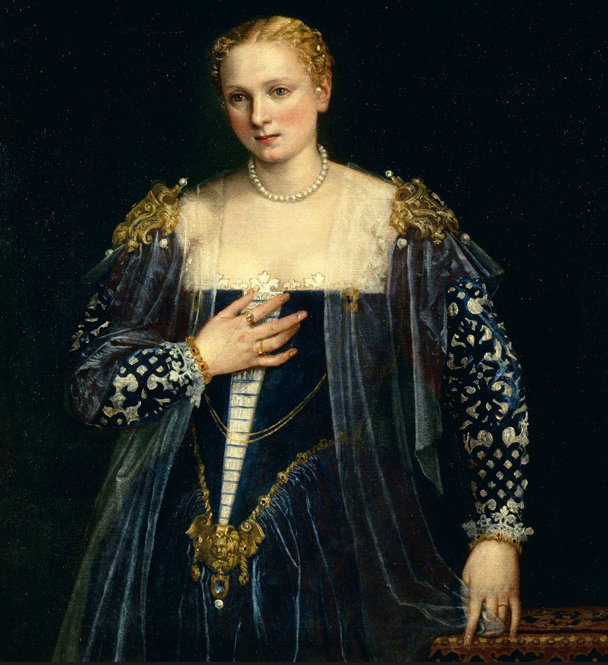
Paolo Veronese (1528-1588), 'Portrait of a Lady, known as the 'Bella Nani'', about 1560-5 Oil on canvas. 119 x 103 cm © Paris, Musée du Louvre, Département des Peintures, RF 2111
Room 3: Altarpieces and Paintings for Churches 1560-1570.
Back out into the flow of visitors who are crowding around a room of altarpieces in silent devotion, listening to the lessons preached by the curators via that modern scourge of the museum- the audio-guide. Or go further back and listen to the sepulchral voice of Ruskin: “The evidence might be accumulated a thousand fold from the works of Veronese, and of every succeeding religious painter, that the fifteenth-century had taken away the religious heart of Venice.” We should not be surprised at Ruskin’s sour tone. For him, Tintoretto’s art enshrined the pious spirit in Venetian art; Titian was a mere painter of whores; and Veronese a competent decorator of palazzi and churches, but this is to do him a disservice. Religious fraternities who commissioned Veronese’s art did not want austerity in their altarpieces; they wanted to enjoy them and use them to beautify their temples and churches. Ruskin’s puritan distaste finds no place in Veronese. These are altarpieces to attract the eye, ranging from the organ doors of the Saints Gemianus and Severus painted in autumnal colours to the eye-catching flaming red drapery of such niche figures as Saint Menna who sticks one armour plated leg imperiously out into the viewer’s space. Trompe d’oeil Venetian style. Apart from this experimentation, Veronese turns to familiar models like Titian’s Pesaro Madonna in the Frari with other works in this section. His marvellous Mystic Marriage of St Catherine rising high up over the room owes much to Titian’s altarpiece, though the latter would never have wrapped fluttering drapery around the classical columns of the temple. However, if I were to choose a favourite altarpiece from this room, I would opt for the more obscure Miracle of St Barnabus, a Cypriot saint who cured the sick by holding the Gospel of Matthew over their heads. There are certain problems with the composition such as the unfortunate effect of the large tome weighing down on the sick man’s head, but my eye is drawn more to the vivid colour scheme of greenish-blue and orange draperies on the saint in the centre.
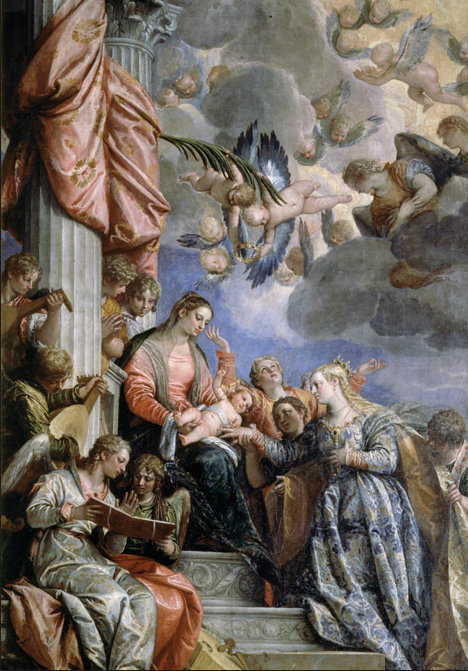
Paolo Veronese (1528-1588), 'The Mystic Marriage of Saint Catherine', about 1565-70 Oil on canvas. 373 x 241 cm Gallerie dell'Accademia, Venice © Soprintendenza Speciale per il Patrimonio Storico Artistico ed Etnoantropologico e per il Polo Museale della Città di Venezia e dei Comuni della Gronda Lagunare, Gallerie dell'Accademia
Room 4: Theatricality and Magnificence, 1565-1580.
There is an embarrassment of riches in this room, but unfortunately that is a problem given the smallness of the space. “Can this cockpit hold the vasty fields of France?” Shakespeare may have solved his problem of presenting the mighty sweep of Henry V in the small, confined space at the Globe, but Xavier Salomon and the designers of this exhibition fail to do justice to the masterpieces in this confined space. There is no question about the quality of pictures in this room, but why was the decision taken to place a huge altarpiece, The Martyrdom of St George in a room where to attain an ideal viewing position, the spectator has to step two or three paces back into the previous room? I found my ideal vantage point and was rewarded with late afternoon light falling on the picture adding to the sense of apotheosis and the call of the divine. The martyrdom is situated on a large support, so I was able to get right up to it and rest my arms on its surface while I studied interesting details like the combination of red, pinks and yellows low down in the picture, or the absurdly long arm of one of the executioners. Anatomy is not one of Veronese’s strong points. Then turning to the right, I see a wall entirely given to the NG’s Family of Darius before Alexander the Great. This again is a perfect example of what could be called the “scatter effect”: the eye darts everywhere alighting on such details as the group of women, dogs and dwarf on the extreme left of the picture. I had not noticed this group before, and it took a drawing by G.D. Tiepolo of that section which I showed in class to make me aware of it and seek it out in this crowded picture. Then there are the barely painted figures at the back of the canvas, almost afterthoughts rather than part of a fully meditated design. Though truly magnificent in its scope and its breadth, I get the impression that this is one vast work in progress, and that one day Veronese might rise from the tomb to put the finishing touches to it. Even the sky, a pinkish gray seems tentatively painted, but that might be the deterioration of the pigment smalt which is not as resilient as ultramarine. He could have afforded this expensive pigment, but he was a contrarian where colour was concerned. Blame it on his provincial training in Verona.
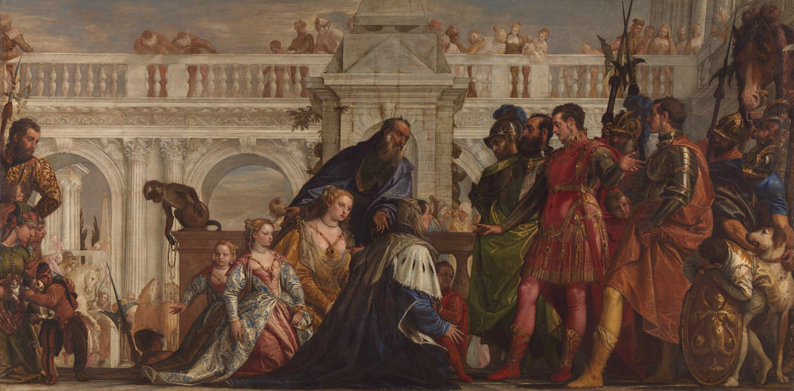
Paolo Veronese (1528-1588) 'The Family of Darius before Alexander', 1565-7 Oil on canvas. 236.2 x 474.9 cm © The National Gallery, London
If Michelangelo was the artistic presence in Room 1, the guiding mind here might be seen as Raphael in some of these pictures. The NG Dream of St Helena is thought to be based on one of his designs as known through a print by Raimondi, and there is a lucid classicism to Veronese’s other version of this subject painted about five years later. It is really a privilege to see the Vatican’s Dream of St Helena which apart from demonstrating the artist’s skill at painting fabrics, suggests he has learnt about economy and elegance via the designs of Raphael: Roman classicism is the watchword here. Other pictures in this room such as the small Prado Finding of Moses or NG Rape of Europa don’t really fit the “magnificence” theme and are mere baubles compared to the larger, grander pictures. Surely it would have been a better idea to cut back on some of these unneccessary trifles and shown some drawings or prints for comparison?
Room 5: Art of Devotion, 1570-1580.
More religious paintings, though not as memorable as the ones in the room just vacated. A Risen Christ, two Adorations of the Shepherds, and a mediocre Preaching of St John the Baptist in sickly colours. I get the feeling that this is a mere overflow from the religious paintings in the previous room. Perhaps this should have been a room given over solely to drawings? Then I would have had far more to say.
Room 6: Allegories and Mythologies 1570-1580.
Into the home stretch now; the crowds are thinning; the end of the exhibition is in sight. I can hardly summon up the strength to confront Veronese’s famous sequence of allegories on love, infidelity or other renaissance pastimes. Then there is the problem of teaching allegory in an age where everything is immediate and the tantalizingly slow lifting of the veil of understanding is reserved for a dwindling group of art historians who want to see paintings as mysteries. One of these, Edgar Wind called the cycle an “erotomachia”, a struggle of love, with the semi-clothed woman turning her back to the viewer an example of Voluptas as imagined by the neo-platonic renaissance philosopher, Ficino. Painting cannot simply be the bearer of messages though, or just visual cryptograms; if it were, one might as well look at engravings and forget about colour and the brushwork altogether. Though not the greatest paintings of the renaissance, and lacking the grace of the figures of Botticelli, Veronese’s allegories succeed in pleasing me with their wit, invention and colours. My favourite is “Happy Union” where an elegant couple are blessed by a deity watched by a cupid and a spirited dog. Veronese loved dogs as much as Titian! See the children playing with the hound in the foreground of the Supper at Emmaus. The NG cycle of love is complemented by a selection of mythologies such as the Met’s beautiful Mars and Venus United by Love.
Room 7: Late Works: 1580-1588.
So the summit is almost reached, the peak rears up in front of me, the last room consisting of nine canvases. My companion pleading exhaustion has fled for the tea rooms abandoning me to my frantic note-taking in front of pictures. Almost two hours spent in the exhibition now. A final mixed bag: two portraits; two mythologies; five religious paintings. The two portraits are good on their own terms, but hardly of surpassing interest. More imagination could have been shown with the choice of portraits overall in this exhibition. The Edinburgh Venus, Mars and Cupid is a lovely late mythology which I know from UK shows; it proves that at this late stage of his career Veronese was still highly skilled at this kind of mythological family group. But the Perseus and Andromeda is a disappointing answer to Titian’s famous version in the Wallace Collection. However, nothing but superlatives for the Vienna Lucretia which in its air of melancholic tragedy and fashionable accoutrements seems to anticipate Rembrandt. Amongst the late devout pictures, two caught my eye: the Agony in the Garden and the Conversion of St Pantalon. The Agony, one of Veronese’s nocturnes, is an appropriate picture to place at the end of a tiring exhibition. The exhausted bundle of Christ borne by a beseeching angel is very moving, and the use of Naples yellow or similar pigments in the drapery heightens the sense of drama effectively. The medium size altar painting of St Pantalon has been spending time on my screen in class of late, so it is very nice to see it in reality. It is the last work in this exhibition, and a worthy picture for the departing visitor to contemplate. Painted for a Venetian church named after the saint, it shows St Pantaleon, an ancient physician intervening to cast out demons from a boy held by a parish priest, Bartolomeo Borghi who commissioned the painting. Among the many things to admire here such as the heads, portraits, are Veronese’s contrasts in light and shade, and colours which set off this fine picture. There is simplicity in the colour here which might be seen as the attainment of a kind of truth in painting.
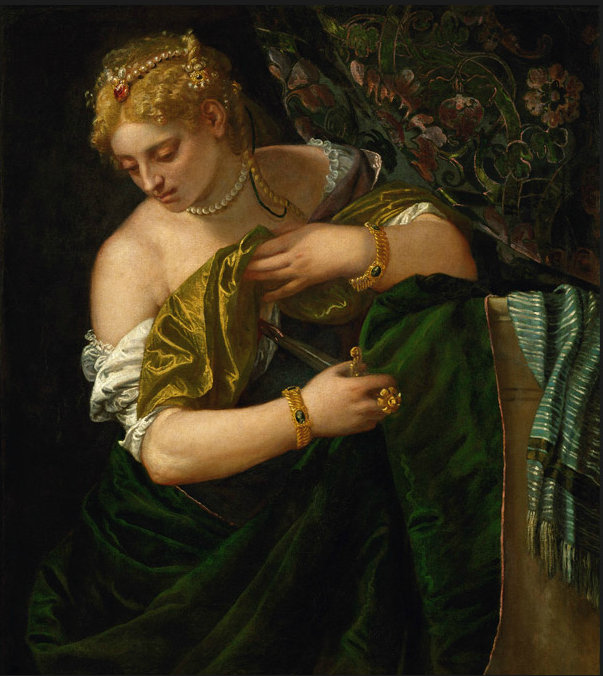
Paolo Veronese (1528-1588), 'Lucretia', about 1580-5 Oil on canvas. 109 x 90.2 cm © Kunsthistorisches Museum Wien Gemäldegalerie
Afterwards, I went in search of some suitable restaurant and I couldn’t help thinking that I had partaken of another kind of meal, a huge banquet with course after course borne to me by curators and scholars. Anyone with an appetite for Venetian colour, or the sheer joy of painting, will not want to miss their place at this sumptuous feast that will satiate any hunger for art. It is true that the organizers of the banquet could have seated us in more congenial surroundings, and they certainly could have thought more about the ingredients that are needed to make a perfect meal; the omission of drawings is baffling, and unforgivable. The curators may not have succeeded totally in bringing Venice to the banks of the Thames, but we cannot fail to congratulate them for putting such wonderful canvases before our ravenous eyes. Most of all we raise our glasses to that most magnificent of painters, Paolo Caliari, Verona’s finest son- Veronese.
© David Packwood 2014
NB David Packwood also writes about art regularly on his website Art History Today.

